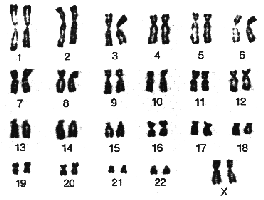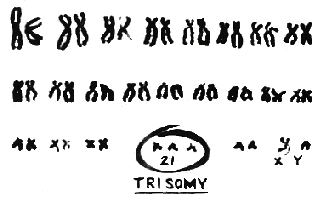May 2009
Trisomy 21: The Story of Down Syndrome
by Len Leshin, MD, FAAP

A Brief History
The formal story began in 1866, when a physician named John Langdon Down published an essay in England in which he described a set of children with common features who were distinct from other children with mental retardation. Down was superintendent of an asylum for children with mental retardation in Surrey, England when he made the first distinction between children who were cretins (later to be found to have hypothyroidism) and what he referred to as "Mongoloids."In the first part of the twentieth century, there was much speculation of the cause of Down syndrome. The first people to speculate that it might be due to chromosomal abnormalities were Waardenburg and Bleyer in the 1930s. But it wasn't until 1959 that Jerome Lejeune and Patricia Jacobs, working independently, first determined the cause to be trisomy (triplication) of the 21st chromosome. Cases of Down syndrome due to translocation and mosaicism (see definitions of these below) were described over the next three years.
The Chromosomes
Chromosomes are thread-like structures composed of DNA and other proteins. They are present in every cell of the body and carry the genetic information needed for that cell to develop. Genes, which are units of information, are "encoded" in the DNA. Human cells normally have 46 chromosomes which can be arranged in 23 pairs. Of these 23, 22 are alike in males and females; these are called the "autosomes." The 23rd pair are the sex chromosomes ('X' and 'Y'). Each member of a pair of chromosomes carries the same information, in that the same genes are in the same spots on the chromosome. However, variations of that gene ("alleles") may be present. (Example: the genetic information for eye color is a "gene;" the variations for blue, green, etc. are the "alleles.")
Human cells divide in two ways. The first is ordinary cell division ("mitosis"), by which the body grows. In this method, one cell becomes two cells which have the exact same number and type of chromosomes as the parent cell. The second method of cell division occurs in the ovaries and testicles ("meiosis") and consists of one cell splitting into two, with the resulting cells having half the number of chromosomes of the parent cell. So, normal eggs and sperm cells only have 23 chromosomes instead of 46.
| This is what a normal set of chromosomes looks like. Note the 22 evenly paired chromosomes plus the sex chromosomes. The XX means that this person is a female. The test in which blood or skin samples are checked for the number and type of chromosomes is called a karyotype, and the results look like this picture. |

|
Many errors can occur during cell division. In meiosis, the pairs of chromosomes are supposed to split up and go to different spots in the dividing cell; this event is called "disjunction." However, occasionally one pair doesn't divide, and the whole pair goes to one spot. This means that in the resulting cells, one will have 24 chromosomes and the other will have 22 chromosomes. This accident is called "nondisjunction." If a sperm or egg with an abnormal number of chromosomes merges with a normal mate, the resulting fertilized egg will have an abnormal number of chromosomes. In Down syndrome, 95% of all cases are caused by this event: one cell has two 21st chromosomes instead of one, so the resulting fertilized egg has three 21st chromosomes. Hence the scientific name, trisomy 21. Recent research has shown that in these cases, approximately 90% of the abnormal cells are the eggs. The cause of the nondisjunction error isn't known, but there is definitely connection with maternal age. Research is currently aimed at trying to determine the cause and timing of the nondisjunction event.
| Here's the karyotype of a male with trisomy 21: |

|
Three to four percent of all cases of trisomy 21 are due to Robertsonian Translocation. In this case, two breaks occur in separate chromosomes, usually the 14th and 21st chromosomes. There is rearrangement of the genetic material so that some of the 14th chromosome is replaced by extra 21st chromosome. So while the number of chromosomes remain normal, there is a triplication of the 21st chromosome material. Some of these children may only have triplication of part of the 21st chromosome instead of the whole chromosome, which is called a partial trisomy 21. Translocations resulting in trisomy 21 may be inherited, so it's important to check the chromosomes of the parents in these cases to see if either may be a "carrier."
The remainder of cases of trisomy 21 are due to mosaicism. These people have a mixture of cell lines, some of which have a normal set of chromosomes and others which have trisomy 21. In cellular mosaicism, the mixture is seen in different cells of the same type. In tissue mosaicism, one set of cells, such as all blood cells, may have normal chromosomes, and another type, such as all skin cells, may have trisomy 21.
The 21st Chromosome and Down Syndrome
The chromosomes are holders of the genes, those bits of DNA that direct the production of a wide array of materials the body needs. This direction by the gene is called the gene's "expression." In trisomy 21, the presence of an extra set of genes leads to overexpression of the involved genes, leading to increased production of certain products. For most genes, their overexpression has little effect due to the body's regulating mechanisms of genes and their products. But the genes that cause Down syndrome appear to be exceptions.
Which genes are involved? That's been the question researchers have asked ever since the third 21st chromosome was found. From years of research, one popular theory stated that only a small portion of the 21st chromosome actually needed to be triplicated to get the effects seen in Down syndrome; this was called the Down Syndrome Critical Region. However, this region is not one small isolated spot, but most likely several areas that are not necessarily side by side. The 21st chromosome may actually hold 200 to 250 genes (being the smallest chromosome in the body in terms of total number of genes); but it's estimated that only a small percentage of those may eventually be involved in producing the features of Down syndrome. Right now, the question of which genes do what is highly speculative. However, there are some suspects.
Genes that may have input into Down syndrome include:
- Superoxide Dismutase (SOD1)-- overexpression may cause premature aging and decreased function of the immune system; its role in Senile Dementia of the Alzheimer's type or decreased cognition is still speculative
- COL6A1 -- overexpression may be the cause of heart defects
- ETS2 -- overexpression may be the cause of skeletal abnormalities
- CAF1A -- overexpression may be detrimental to DNA synthesis
- Cystathione Beta Synthase (CBS) -- overexpression may disrupt metabolism and DNA repair
- DYRK -- overexpression may be the cause of mental retardation
- CRYA1 -- overexpression may be the cause of cataracts
- GART -- overexpression may disrupt DNA synthesis and repair
- IFNAR -- the gene for expression of Interferon, overexpression may interfere with the immune system as well as other organ systems
Other genes that are also suspects include APP, GLUR5, S100B, TAM, PFKL, and a few others. Again, it is important to note that no gene has yet been fully linked to any feature associated with Down syndrome.
One of the more notable aspects of Down syndrome is the wide variety of features and characteristics of people with trisomy 21: There is a wide range of mental retardation and developmental delay noted among children with Down syndrome. Some babies are born with heart defects and others aren't. Some children have associated illnesses such as epilepsy, hypothyroidism or celiac disease, and others don't. The first possible reason is the difference in the genes that are triplicated. As I mentioned above, genes can come in different alternate forms, called "alleles." The effect of overexpression of genes may depend on which allele is present in the person with trisomy 21. The second reason that might be involved is called "penetrance." If one allele causes a condition to be present in some people but not others, that is called "variable penetrance," and that appears to be what happens with trisomy 21: the alleles don't do the same thing to every person who has it. Both reasons may be why there is such variation in children and adults with Down syndrome.
Toward the Next Century
Researchers are busy in their attempts to map out the full structure of the chromosome, including the Human Genome Database. Because of the small size of the 21st chromosome and its association with Down syndrome, it is the second-most heavily mapped human chromosome. Research is focusing on trying to identify genes and their effects when overexpressed.
However, it would be a mistake to assume that the clinical features of Down syndrome are only due to a handful of genes being overexpressed. You can think of the overexpressed gene products interacting with a number of normal gene products, each product individualized by the person's unique genetic makeup, and thus being thrown "out of genetic balance." This would then make the person more susceptible to other genetic and environmental insults, leading to the features, diseases and conditions associated with Down syndrome. It is this complex arrangement that scientists will be addressing in the second century of Down syndrome research.
Related links:
- Dr. Langdon Down's original paper: Observations
on an Ethnic Classification of Idiots
(ethnically incorrect but historically interesting) - Risk and Recurrence of DS, by Dr. Paul Benke (includes a more detailed discussion of translocation)
- My essay on Mosaic Down Syndrome
References:
- Coleman, Mary and Rogers, PT. Medical Care in Down Syndrome: A Preventative Medicine Approach. Marcel Dekker, Inc, NY, 1992.
- Korenberg, JR et al. Down syndrome phenotypes: The consequences of chromosomal imbalance. Proc. Natl. Acad. Sci. USA, 91: 4997-5001, 1994.
- Patterson, D. The integrated map of human chromosome 21. In Etiology and Pathogenesis of Down Syndrome, Wiley-Liss, 1995, p 43-55.
- Hernandez D and Fisher EMC. Down syndrome genetics: unravelling a multifactorial disorder. Hum. mol. Genet., 5: 1411-1416, 1996.
- Shapiro, BL. Whither Down syndrome critical regions? Hum Genet 99: 421-423, 1997.